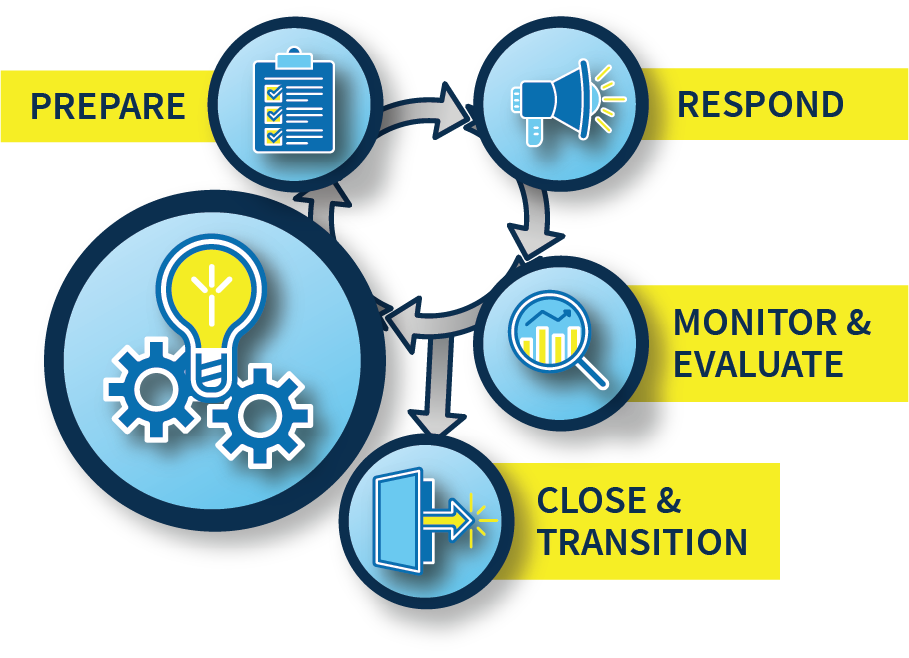Refine the Campaign



REVISE, REFINE, AND ITERATE

REFINE THE CAMPAIGN BASED ON SITUATIONAL CHANGES AND SCIENCE UPDATES

REFINE AND DEVELOP COUNTER MESSAGING TO PROMOTE AN ACCURATE AND BALANCED NARRATIVE

REFINE CAMPAIGN OPERATIONS
REVISE, REFINE AND ITERATE
Like actions on monitoring and evaluation (Monitor and Evaluate), activities that require data-driven refinement are stratified at the campaign’s programmatic, strategic, and operational levels to track progress through the stages of community activation. See Figure 6 below (also represented in Define Desired Outcomes).

Stages of Community Activation
REFINE THE CAMPAIGN BASED ON SITUATIONAL CHANGES AND SCIENCE UPDATES
- Scientific discovery
- Disease biology (e.g., pathogen resistance)
- Epidemiology (e.g., incidence, prevalence, morbidity, mortality, affected populations)
- Health resource availability (e.g., medicines, medical equipment, medical staff)
- Social factors (e.g., public attitudes and behaviors, including compliance with public health guidance)
- Political or economic factors (e.g., national, state, and local policies; political leadership; budgetary changes)
Following the governance decision model (PREPARE for the Community Activation Campaign), changes are managed through streamlined practices where the CMT is empowered to make agile, tactical adjustments to operational plans.
Additional Information about Refining the Campaign Based on Situational Changes and Science Updates
The CMT should regularly inform the oversight team of general campaign progress and elevate risks or opportunities that may require the oversight team to reallocate resources or reprioritize actions.
As both campaign teams assess objectives within the decision framework, data changes and signals from campaign activities (RESPOND: Develop and Execute the Community Activation Campaign) can trigger action by the oversight team or escalation and recommendations from the CMT.
Decision makers can support creation of models, dashboards, and visualization tools using multiple sources to populate the tools. These sources can include:
- Website telemetry
- Paid media analytics
- Predictive modeling
- Social listening
- Sentiment analysis
- Audience analysis
The oversight team should review recommendations for meaningful change, and approve, deny, or modify suggested tactical refinements from the CMT. In this way, the campaign can use the decision framework as an active management tool to ensure it continues through the stages of community activation.
|
|
Key Decisions Activities to Implement Campaign Refinements
- Obtain and compile all insights and information.
- Evaluate the need for a response using the data-driven decision framework and identify the applicable levers available to refine the campaign.
- Determine an appropriate response, for example:
- Should the scope of the campaign response strategy contract or expand?
- Should the campaign shift priorities, locations, or audience?
- Should the paid media or community partners’ strategic operations plans be refined?
- Should the campaign develop additional risk mitigation strategies?
- Should the campaign decrease efforts or close due to reduced need?
- Modify or refine the response strategy and/or operations informed by data-driven decisions.
Refine and Develop Counter Messaging to Promote an Accurate and Balanced Narrative
Key Decisions and Activities to Produce Counter Messaging
- Obtain examples of misinformation and disinformation, either online or within the community (e.g., articles, posts, media clips, publications, quotes).
- Assess the current message(s) in the context of online narratives, and obtain insights from trusted experts (e.g., the clinical and scientific advisory group) to ensure scientifically accurate message refinement or counter-message development.
- Leverage the data-driven decision framework to decide whether and how to respond.
- Develop a counter-messaging narrative.
- Re-align messaging based on stakeholder concerns
- Aggregate positive messages into a stronger single narrative.
- Determine how the counter-message(s) will be disseminated.
- Consider the audience that will receive the message.
|
- Determine the message elevation plan to map out how campaign counter-messages will be accessed and engaged with by the audience.
- Identify or develop creative assets to carry the message(s).
- Select credible messengers.
- Determinate the platforms and/or channels where the message(s) can be disseminated.
- Evaluate whether additional efforts or resources may be necessary to address changes in public sentiment affected by the misinformation.
- Refine the campaign messaging strategy and operational plans based on counter-message development and message elevation plans. This may include shifting channel tactics, engaging additional stakeholders, and/or creating new assets. See the resource Example Counter Messaging Plan for an example plan.
- Review creative assets and edit as necessary for all campaign languages.

Balancing the NarrativeTo counter confusion from disinformation about the donation process, the FCR team developed “myth busting” social media content to address the topics directly. Research studies with vastly differing designs were published and results discussed comparatively in online health provider conversations. FCR created a content series aimed at educating providers about evaluating scientific study design before drawing conclusions.

Refine Campaign Operations
Operational Examples of Data-Driven Refinements
- Communication hub content
- Refinement: Redesign website content to be more appealing or engaging.
- Source information: Website metrics and telemetry (e.g., number of webpage hits, length of time on the website, user activity on the website, bounce rate) indicate low audience engagement with specific website content.
- Paid search tactics
- Refinement: Execute strategic website changes to improve search engine optimization (SEO) with new keywords, relevant links, and other insights to increase website traffic from search engines.
- Source information: Search results performance, such as search rankings and total number of links pointing to the website, indicate website content could be more prominent in organic search results.
- Social media tactics
- Refinements: Shift resources to more effective channels, leverage platform algorithms over manual audience targeting tactics, increase use of top-performing creative assets to optimize campaign reach and recognition.
- Source information: Paid social media metrics such as reach, impressions, engagement, and click- through rate (CTR) indicate campaign content on specific social media channels, and certain assets in particular, lack audience engagement.
- Earned media tactics
- Refinements: Shift story pitching forums, shift outlet outreach from national to local (or vice versa), amplify or constrain messaging.
- Source information: Shifts in relevant news cycles, the state of the science, public and professional sentiment, news outlet tone and relevance, and/or spokesperson willingness indicate campaign messaging no longer resonates as intended with earned media channels.
|
- Paid media/display tactics
- Refinements: Adjust the media mix, markets, or budgets (e.g., less frequent rotation of placements, fewer channels, more expedient timeslots).
- Source information: Audience reach, and exposure frequency metrics indicate assets do not perform as desired on existing media channels and/or schedules.
- Creative asset performance
- Refinements: Modify digital asset type, design, or production; focus on the type of assets with the best overall performance in a particular channel or medium; retire asset types that fail to amplify or resonate.
- Source information: CTR, impressions, play time and frequency of plays (for radio, video, or motion assets), and/or A/B testing results indicate certain creative materials engage the intended audience better than others.
- Message design
- Refinements: Realign messaging type or adjust messengers.
- Source information: Message testing with community stakeholders (e.g., in focus groups) indicates current messages do not resonate with the audience, and/or current messengers are not trusted.
- Community engagement
- Refinements: Increase, decrease, or otherwise change partner targets, including number, type, or asks; move resources; or provide additional support to secure partner connections in desired region(s).
- Source information: Engagement data and local ecosystem information (e.g., partner pipeline, gaps in specific regions, partner activities, community engagement team performance against operational goals) indicate that shifts in partner outreach tactics are necessary to achieve the desired impact in target communities.





